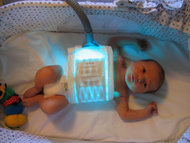Introduction
Jaundice comes from the French word "jaune", which means yellow. When it is said a baby is jaundiced, it simply means that the colour o f the skin appears yellow, which is often seen in the first few days after birth. The yellow colour is due to the bilirubin that is produced when red blood cells get old and are broken down by the body. Most often, newborns with hyperbilirubinemia are treated with phototherapy. Thus, it was envisaged that development of a valid protocol for care of newborns with hyperbilirubinemia would help practicing nurses to act promptly and independently.
Objectives
The objectives of the study are to:
1 Find the incidence of hyperbilirubinemia among full term newborns delivered in a selected hospital for a period of six months.
2 Find the association between level of bilirubin and selected factors:
(a) Maternal factors: age, blood group, gestational diabetes, antepartum hemorrage and maternal trait anxiety
(b) Neonatal factors: gender, birth weight, gestational age, history of jaundice in siblings, initiation of breast feeding, birth injury and blood group.
3 Find the association between invasive and non-invasive method of assessment of bilirubin level.
4 Identify the effect of Photo-therapy on hyperbilirubinemia in terms of degree of dehydration and loss of weight in newborns undergoing the same.
5 Find relationship between serum bilirubin level and duration of Phototherapy.
6 Identify the care needs of newborns undergoing Phototherapy and prioritise the needs.
7 Develop and validate a care protocol for full term newborns with hyperbilirubinemia based on identified needs.
Methodology:
The study was carried out in three phases. An exploratory research approach was adopted for the first two and the third phase was evaluative. The study was conducted at Kasturba Hospital Manipal. For phase I, all records of full term newborns in the hospital for a period of six months i.e, 1st January 2002 to 30lh June 2002 were included. For phase II, all full term newborns born in two months time were considered; out of these, it was expected to get 20-30 newborns with hyperbilirubunemia. Sampling critereia was established and by using validated and reliable tools (r=l,0.96,0.95,0,94) data were collected by record analysis, interview, observation and measurement.
Analysis and findings
The data were analysed using descriptive and inferential statistics with the help of computer using statistical package for social sciences "SPSS-9.0" version. Incidence of hyperbilirubinemia in a period of six months was found to be 198 per 1000 population, e.i. 20 percentage of the total population were diagnosed as having neonatal hyperbilirubunemia with bilirubin level >= 12mg/dl. All these newborns were treated with Phototherapy. The selected maternal and neonatal variables were independent of level of bilirubin. No significant association was found between invasive and non-invasive assessment of bilirubin level which indicated that both type of assessment were independent of themselves. Degree of dehydration was independent of duration of Phototherapy whereas, loss of weight had and significant relationship with duration of phototherapy. (r=0.466 .
Conclusions
Neonatal hyperbilirubinemia is a common problem among newborns. No significant association found between the level of bilirubin and selected factors under study. Each method of assessment of bilirubin level is independent of each other. Therefore non-invasive method alone is not a reliable way to predict the presence or absence of hyperbilirubinemia.
Duration of phototherapy had influence on loss of weight of newborns. Hyperbilirubinemia can be managed with phototherapy unless there is urgent need for any other treatment. Protocol was found to be usable and acceptable.
Implications
Nursing practice and education
Nursing personnel need to be aware of common neonatal illnesses. Protocol can be used to learn how to assess newborn, determine approximate level of bilirubin by noninvasive method. Nurses also need to give more attention to baby friendly hospital policy and also encourage mothers to breastfeed when a newborn undergoes phototherapy, thus promote bonding and reduce the effect of separation of newborn from the mother.
Nursing research
Research studies can be conducted by considering various other factors and to find if at all phototherapy is required for treatment of hyperbilirubunemia.
Bibliography
1 Alpay, F., Sarici. S.U., Tosuneuk, H.D., Serder, M.A., Inanc, N and Gokcay, E (2000). The value of first day bilirubin measurement in predicting the development of significant hyperbilirubinemia in healthy term newborns. Pediatrics, 106(2), E16.
2 Arif, K. and Bhutta, Z.A. (1999). Risk factors and spectrum of neonatal jaundice in a birth cohort in Karachi. Indian Pediatrics, 68 (6), 130-134.
3 Avery, G. B., Fletcher, M. A. and MacDonald M. G. (1994). Neonatology, Patho physiology and management of newborns. Lon-don : Mosby.
4 Awasthi and Rehman, H. (1998). Early prediction of neonatal liyperbilirubinemia. Indian Journal of pediatrics, 65 (1) 131-139.
5 Burns, N and Grove, S. K. (1987). The Practice of Nursing Research. Philadelphia: W.B. Sounders Company.
6 Giarcilli, E., Pisano, R. and Mecorkle, R. (2000). Stable and Able. American Journal of Nursing. 100 (12), 26-31.
7 Melton, K. and Akinbi, H. (1999) Neonatal Jaundice to reduce bilirubin induced complications. Postgraduate Medicine, 167-168, 171-174, 777-778.
8 Moyer, V.A. (2000). Accuracy of Clinical Judgment in Neonatal Jaundice Archives Pediatrics Adolescent Medicine. 154, pp391-394.
Author :
Associate Professor, College of Nursing, MAHE, Manipal-576119, Karnataka.
Copyright Trained Nurses' Association of India Jul 2003
Provided by ProQuest Information and Learning Company. All rights Reserved



